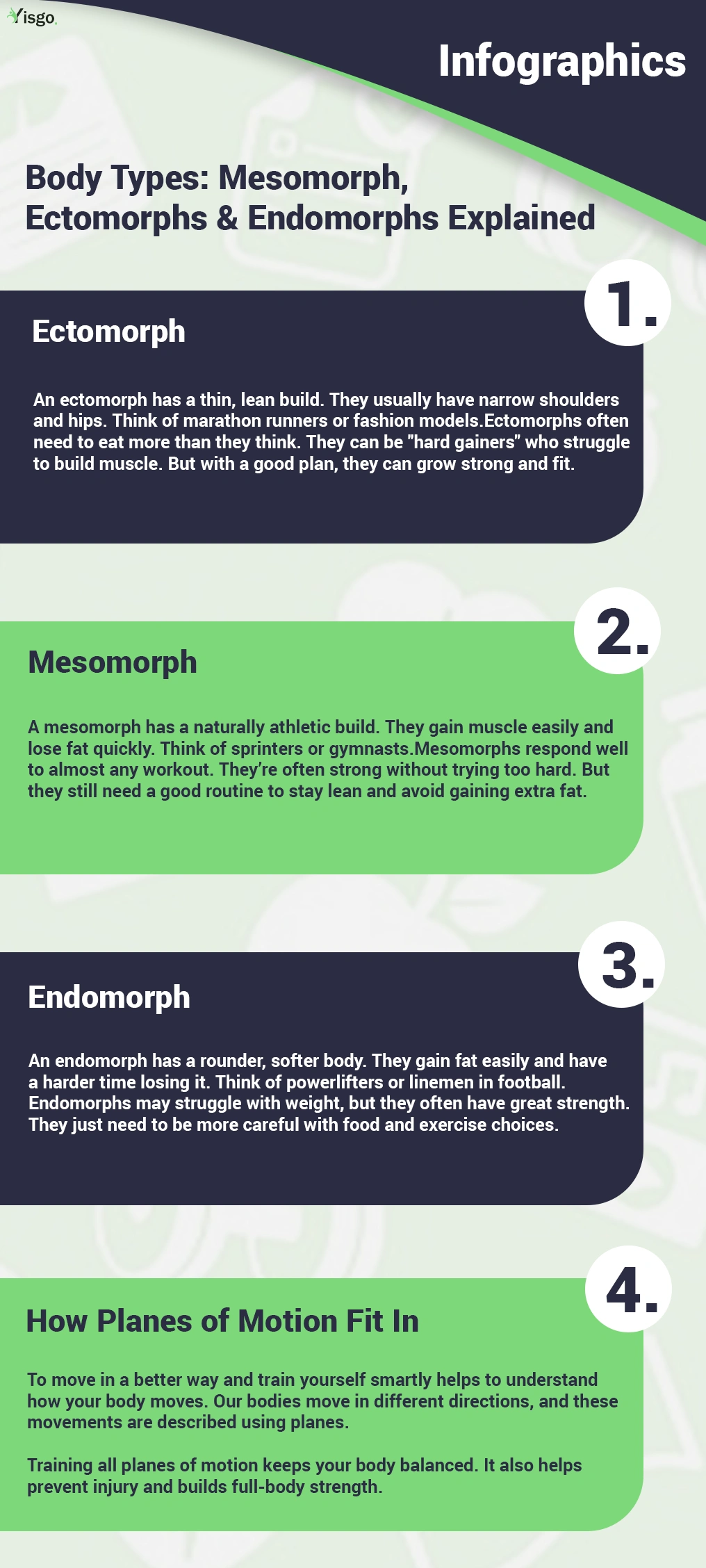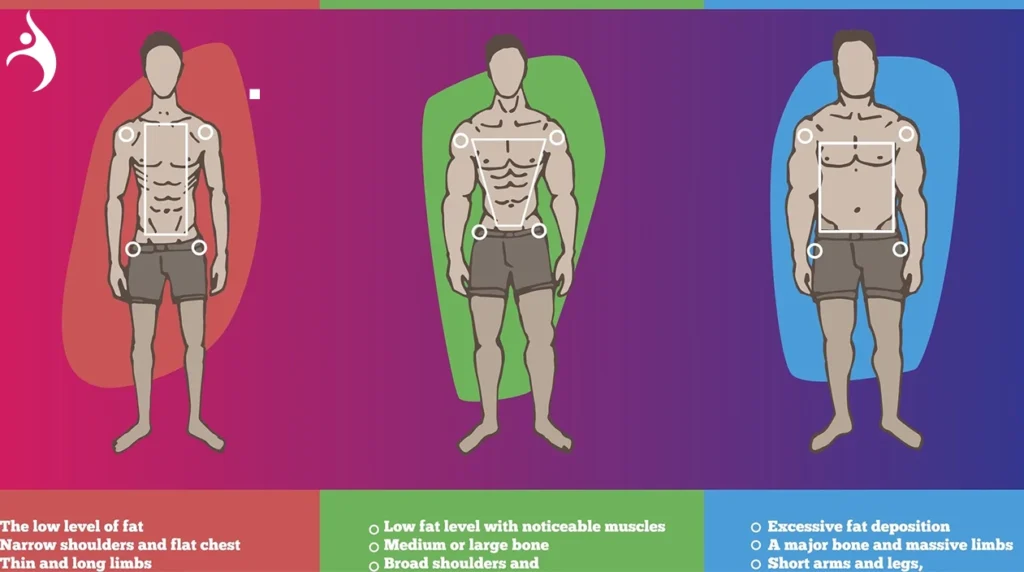Our bodies are all different. Some people are naturally slim. Others are more muscular. Some gain weight easily. These differences often come down to body types. There are three main types of bodies i.e, ectomorph, mesomorph, and endomorph.
Once you understand your body type, you can choose the best foods to eat, the best way to exercise, and how to reach your health goals.
In this blog, we will break down each body type and how you can work with your natural shape. We’ll also elaborate on how your body moves using planes of motion, like the coronal (frontal) plane, sagittal plane, and transverse (horizontal) plane.
What Are the 3 Main Body Types?
The concept of different body types was introduced in the 1940s by a psychologist named, William Sheldon. He believed people fit into one of the three main shapes, and they are:
- Ectomorph
- Mesomorph
- Endomorph
Most people are not 100% one type. You may be a mix. But knowing your main type can be a helpful starting point.

Body Types Explanation
Ectomorph
An ectomorph has a thin, lean build. They usually have narrow shoulders and hips. Think of marathon runners or fashion models.
Body Traits:
Slim and long
Fast metabolism
Hard to gain weight or muscle
Often has small joints and bones
Best Way to Eat:
Ectomorphs need more calories to gain weight.
Focus on carbs and protein.
Eat often: 5–6 meals a day.
Sample Macro Plan:
55% carbs
25% protein
20% fat
Exercise Tips:
Focus on strength training.
Do less cardio.
Aim to build muscle.
Hand Portion Guide:
1-2 palms of protein foods at each meal
1-2 fists of vegetables
3-4 cupped handfuls of carbs
1-2 thumbs of fats
Ectomorphs often need to eat more than they think. They can be “hard gainers” who struggle to build muscle. But with a good plan, they can grow strong and fit.
View this blog: What Is Precision Nutrition Therapy & Why It Matters
Mesomorph
A mesomorph has a naturally athletic build. They gain muscle easily and lose fat quickly. Think of sprinters or gymnasts.
Body Traits:
Naturally muscular
Strong and solid
Broad shoulders
Gains or loses weight easily
Best Way to Eat:
A balanced diet works best.
Focus on quality carbs, lean protein, and healthy fats.
Sample Macro Plan:
40% carbs
30% protein
30% fat
Exercise Tips:
Combine strength and cardio training.
Try activities like weightlifting, HIIT, and sports.
Hand Portion Guide:
1-2 palms of protein foods
1-2 fists of vegetables
2-3 cupped handfuls of carbs
2-3 thumbs of fats
Mesomorphs respond well to almost any workout. They’re often strong without trying too hard. But they still need a good routine to stay lean and avoid gaining extra fat.

Endomorph
An endomorph has a rounder, softer body. They gain fat easily and have a harder time losing it. Think of powerlifters or linemen in football.
Body Traits:
Curvy or stocky
Slower metabolism
Gains weight quickly
Harder to stay lean
Best Way to Eat:
Focus on protein and fats
Lower carbs
Limit sugar and refined grains
Sample Macro Plan:
35% protein
25% carbs
40% fat
Exercise Tips:
Do regular cardio
Include strength training
Stay active every day
Hand Portion Guide:
1-2 palms of protein foods
1-2 fists of vegetables
1-2 cupped handfuls of carbs
3-4 thumbs of fats
Endomorphs may struggle with weight, but they often have great strength. They just need to be more careful with food and exercise choices.
Why Body Type Matters
Your body type isn’t your fate. It just helps you understand how your body responds to food and exercise. Many people blame their body type for their struggles. But with the right plan and acting upon it with proper enthusiasm, everyone can reach his/her fitness goals.
When you are familiar with the type of body you have, you will not compare yourself to other people who have a different type of body. Therefore, you should understand the fact that if you’re an ectomorph, you won’t gain muscle as fast as a mesomorph, and that is definitely not a problem! You just need a different plan of action to get your ideal body type.

Check this blog: Deadlifts: Should It Be on Leg Day or Back Day?
How Planes of Motion Fit In
To move in a better way and train yourself smartly helps to understand how your body moves. Our bodies move in different directions, and these movements are described using planes.
- Sagittal Plane Movements: This is forward and backward motion. Think of running, squats, or bicep curls.
- Coronal/Frontal Plane Movements: This is side-to-side movement. Think of jumping jacks or side lunges.
- Transverse (Horizontal) Plane Movements: This involves rotation. A good example of transverse movement is swinging a bat or doing a Russian twist.
These planes of motion are used by all body types. But depending on your body shape, some moves may be easier or harder.
- Ectomorphs may be great at sagittal plane movements due to their light frames.
- Mesomorphs often do well across all planes of movement.
- Endomorphs may need to work more on frontal plane mobility and horizontal plane exercises to improve balance and core strength.
Training all planes of motion keeps your body balanced. It also helps prevent injury and builds full-body strength.
How Planes of Motion Connect to Body Types
Understanding body types is not just about appearance. It also helps explain how our bodies move. That is where the planes of motion takes the stage. Basically, our body moves in three main planes i.e, the sagittal plane, coronal (or frontal) plane, and transverse (or horizontal) plane.
- Sagittal plane movements include forward and backward motions. Think of running, squatting, or doing bicep curls.
- The coronal/frontal plane divides the body into front and back. Movements here include side lunges or jumping jacks.
- The horizontal plane (also known as the transverse plane) includes twisting or rotational actions, like swinging a bat or doing a Russian twist, etc.
Different body types tend to move and perform better in certain planes e.g, mesomorphs are strong and naturally balanced, and often excel in all planes. Ectomorphs may do better in sagittal plane movements like running due to their lighter frames. While endomorphs might need more practice and mobility work to move efficiently in the transverse plane.
Training Tips for Each Body Type
Ectomorphs: Training should focus on building strength and muscle. Compound lifts like squats, deadlifts, and bench presses , etc. work well. Ectomorphs should train in the sagittal plane often but also challenge themselves with rotational and lateral movements for balance.
Mesomorphs: They are naturally athletic. Use full-body workouts and switch up the planes of movement regularly. Include exercises like burpees (sagittal), side lunges (coronal), and med ball throws (transverse), etc. to build power in every direction.
Endomorphs: These individuals benefit from higher-intensity workouts and strength training. Combine strength work with cardio. Add movements from all planes of motion, especially the frontal plane, to boost flexibility and mobility.
See this blog: Why Eating Whole Foods Is the Key to Healthier Living
Example of Transverse Movements by Body Type
The transverse plane involves rotation and twisting. It’s crucial for real-world movement, like turning while running or pivoting in sports.
- Ectomorphs can use transverse movements i.e, medicine ball twists or cable woodchoppers to improve core strength and balance.
- Mesomorphs can boost their power with transverse exercises like rotational slams or landmine rotations.
- Endomorphs should perform controlled transverse exercises (like standing torso rotations) to increase core stability and mobility.
By training in the transverse/horizontal plane, all body types improve their athletic performance and reduce injury risk.
Therefore…
You can become healthier, stronger, and more confident, no matter what body shape you got. You don’t have to fit perfectly into any one type of box.
You can start your journey today, start from whereever you are, stay consistent, and keep learning what works best for your unique body.
